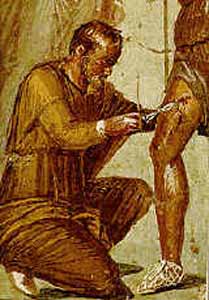

Early Romans had a religious, yet fundamental understanding of medicine. Deriving knowledge from the Medical Treatises and Methods of the Greeks, the Etruscans, the Egyptians, the Persians and other conquered peoples, the Romans came up with one of the best and most sophisticated Medical Systems of the Ancient World. The science of medicine and the human body was evolving.
Many Greek medical ideas were adopted by the Romans and Greek medicine had a huge influence on Roman medicine. The first doctors to appear in Rome were Greek, captured as prisoners of war. Greek doctors would later move to Rome because they could make a good living there, or a better one than in the Greek cities.
The Romans also conquered the city of Alexandria, with its libraries and its universities. In Ancient times, Alexandria was an important centre for learning and its Great Library held countless volumes of information, many of which would have been on medicine. Here, doctors were allowed to carry out dissections which led to the discovery of many important medical advances, such as the discovery that the brain sends messages to the body.
Greek Medicine revolved heavily around the theory of the Four Humours and texts by Hippocrates and his followers (Hippocratic Writings), who were all Greek. These ideas and writings were also used in Roman medicine. Roman Medicine also encompassed the spiritual beliefs of the Greek.
Ancient Roman medicine was a combination of physical techniques using various tools and holistic medicine using rituals and religious belief systems. Many believed that diseases were brought on by the disfavor of the gods. They deeply believed that transcendental practices such as superstition, rituals, and a belief in spells would rid them of disease. Since many diseases soon or later went away, they believed they had managed to please the gods by performing the correct religious and spiritual acts. Religious cures were rare but magical treatment was commonly applied.
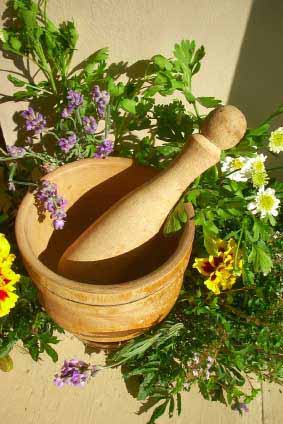
Fennel: It was thought to have calming properties.
Elecampane: Used to help with digestion.
Sage: Although it had little medicinal value, it had great religious value.
Garlic: Beneficial for health, particularly of the heart.
Fenugreek: Used in the treatment of pneumonia.
Silphium: Used for a wide variety of ailments and conditionsŃespecially for birth control.
Willow: Used as an antiseptic
The practice of reading livers was common in the Roman world. After an animal was sacrificed its liver
was examined by a priest who would interpret the liver. Looking at the liver, the priest would reveal good or bad omens from it. It was thought that the gods responses were communicated through the liver and other internal organs of a sacrificed animal. Healing was sought after from religious temples. Sacrifices were made to gods in particular Asklepios (see below) in hopes of receiving healing.
Hospitals were originally built for the military. Under Gaius Marius, the Roman Army became the world's best trained and disciplined force, and some of this rubbed off onto the Medics too. The influence of superstitious quackery lessened and Roman Medicine took on a more practical approach. It was still a trial and error process, but the Medics were more observant and carefully noted down any treatment that worked and this knowledge was passed on and could be successfully utilized by the next doctor.
The fifteen-year civil war that directly following the assassination of Julius Caesar led to significant medical innovations. The war was fought between the best armies of the world and yielded such high levels of injury that the newly emerged emperor, Augustus, formed a professional military medical corps. Before this, doctors had fairly low status. August, realizing that they were key in an empire and especially an army, gave all physicians that joined his new army medical corps dignified titles, land grants, and special retirement benefits! For the next five hundred years, fueled by the motivations and opportunity for medical advancement supplied by the many battles, and supported by the powers that be, this serious group advanced the study and practice of medicine to a level not seen again until late in the nineteenth century.
The first Roman Medical Corps was formed by Emperor Augustus, and as he gave land grants, dignified titles, and special retirement gifts to the doctors, the profession lost its shoddy aspect and became respectable. It helped too that Medical professionals hereafter were required to train at the new Army Medical School and could not practise unless they passed. This increased the success rates in treatments.
Ancient Roman medicine was, surprisingly, incredibly similar to that of the late nineteenth century. Like the modern medical practice, Ancient Roman medicine was split among different specialties, such as internists, ophthalmologists, and urologists. All surgical tasks were only preformed by appropriate specialists. Surgeons used practically the same tools as American doctors did only one hundred years ago. An Ancient Roman doctorŐs tool kit (shown in the four pictures to the right) would include forceps, scalpels, catheters, and even arrow-extractors.
Similarly, Ancient Roman surgeons had a wide range of painkillers and sedatives to help in surgery, including extracts of opium poppies (morphine) and of henbane seeds (scopolamine). There is little doubt that the many folk remedies used throughout the Roman Empire were tested in battle by Roman physicians on wounded and ailing soldiers, who sifted through and found the treatments and methods with the most useful effects. Further, the bureaucracy of Rome ensured that the treatments were recorded and taught in the medical school.
The Romans did not yet really understand how germs related to disease, but they did use many of the techniques that killed germs, techniques that were not reinvented until much later. For example, they boiled their tools before use and would not reuse the same tool on a patient before reboiling. Wounds were washed with acetum, which is actually a better antiseptic than Joseph Lister's carbolic acid (Joseph Lister rediscovered antiseptics in the 1860's, based on Louis PasteurŐs brand-new germ theory of disease).
In Ancient Rome, it was common knowledge that arteries and veins carried blood. All surgeons knew how to use tourniquets, arterial clamps, and ligatures to stem blood flow. They also used amputation to prevent deadly gangrene.Over the years, Roman war doctors also learned how to prevent many battlefield epidemics. They accomplished this by placing forts away from insect infested swamps. They also installed drains and sewers to transport sewage away from the men.
Similarly, they invented sophisticated permanent hospitals, with specialized rooms for different tasks, and with isolation of some patients from others to reduce the spread of disease. Central heating and good ventilation also helped patients.
In the case of the Roman army, it is clear that it was the wartime doctors that created most of the innovations because they were organized, they were distributed throughout the Empire, they were careful about capturing and spreading any new information or technique that worked, and they were highly motivated by the great loss of life suffered by their soldiers during the many battles.
Roman doctors did not necessarily fare well. Many doctors were freed Greek slaves, hence the social standing of doctors was quite low. Because cure rates were so low, many people were skeptical or even scornful of doctors. Their skepticism is easily understood. Roman literature contains much which tells us about the reactions of individuals to medicine and doctors. To listen to the Roman authors is to hear tales of quackery at all levels of society.
Some doctors charged excessive prices for the most worthless medicines and drugs, and others in the craft attempt to deal with and treat diseases they obviously do not understand.
There were no licensing boards and no formal requirements for entrance to the profession. Anyone could call himself a doctor. If his methods were successful, he attracted more patients, if not, he found himself another profession. Medical training consisted mostly of apprentice work. Men trained as doctors by following around another doctor.
Rome had two types of physicians:
Those who served the general public whose reputation wasn't as prestigious. Many were illiterate, quacks, charlatans, and usually cheated the poor and needy.
Unethical practices abounded. Plutarch grumbled that practitioners used all sorts of questionable methods to gain patients, ranging from escorting the prospective patient home from bars to sharing dirty jokes with him. According to Plutarch, "Some Medical Quacks would do just about anything to acquire clients, from accompanying them to alcohol dens to telling them dirty jokes. Still others were not above murdering their patients in cold blood for financial gain, for example, they might be paid and told to just 'put the patient out of his misery'."
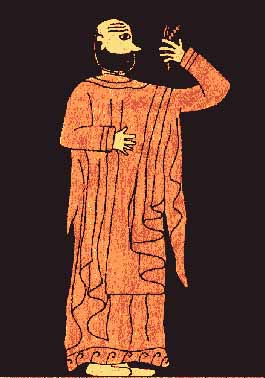
Roman Medics studied medical texts by Hippocrates, who came from the Greek Island of Cos and is generally regarded as the Father of Medicine. Actually, he was only one of a longstanding line of medical practitioners, but his personal popularity ensured that his treatises were saved by his followers while those written by his predecessors, which nobody saved, were lost to the coming ages.
Archaeological sites have produced many implements used in ancient Roman surgery - some dating to 460 BC. This is the timeline Hippocrates wrote The Oath - a pledge still taken today by doctors to perform to their fullest ability.
The Hippocratic Oath is an oath historically taken by physicians, physician assistants' and other healthcare professionals swearing to practice medicine ethically and honestly. It is widely believed to have been written by Hippocrates, often regarded as the father of western medicine, or by one of his students. The oath is written in Ionic Greek (late 5th century BC), and is usually included in the Hippocratic Corpus. Classical scholar Ludwig Edelstein proposed that the oath was written by Pythagoreans, a theory that has been questioned due to the lack of evidence for a school of Pythagorean medicine. Of historic and traditional value, the oath is considered a rite of passage for practitioners of medicine in many countries, although nowadays the modernized version of the text varies among them. The Hippocratic Oath (orkos) is one of the most widely known of Greek medical texts. It requires a new physician to swear upon a number of healing gods that he will uphold a number of professional ethical standards.
Besides the writings of Hippocrates, other writers wrote on medical topics. There were Medical Practitioners whose writings were equally revered:
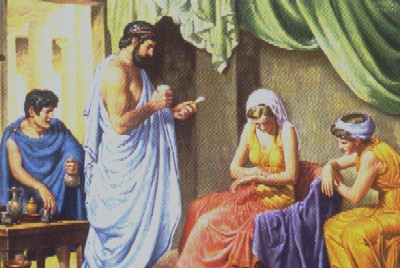
Galen (AD 129 - ca. 200 or 216) of Pergamon was a prominent ancient Greek physician, whose theories dominated Western medical science for well over a millennium. By the age of 20, he had served for four years in the local temple as a therapeutes ("attendant" or "associate") of the god Asclepius. Although Galen studied the human body, dissection of human corpses was against Roman law, so instead he used pigs, apes, and other animals. Galen moved to Rome in 162. There he lectured, wrote extensively, and performed public demonstrations of his anatomical knowledge. He soon gained a reputation as an experienced physician, attracting to his practice a large number of clients. Among them was the consul Flavius Boethius, who introduced him to the imperial court, where he became a physician to Emperor Marcus Aurelius. Despite being a member of the court, Galen reputedly shunned Latin, preferring to speak and write in his native Greek, a tongue that was actually quite popular in Rome. He would go on to treat Roman luminaries such as Lucius Verus, Commodus, and Septimius Severus. However, in 166 Galen returned to Pergamon again, where he lived until he went back to Rome for good in 169.
Pedanios Dioscorides (65 A.D.)Pedanius Dioscorides (ca. 40-ca. 90) was an ancient Greek physician, pharmacologist and botanist from Anazarbus, Cilicia, Asia Minor, who practised in ancient Rome during the time of Nero. Dioscorides is famous for writing a five volume book De Materia Medica that is a precursor to all modern pharmacopeias, and is one of the most influential herbal books in history.
Soranus was a Greek physician, born at Ephesus, who lived during the reigns of Trajan and Hadrian (AD 98-138). According to the Suda, he practiced in Alexandria and subsequently in Rome. He was the chief representative of the school of physicians known as "Methodists." His treatise Gynaecology is extant (first published in 1838, later by V. Rose, in 1882, with a 6th-century Latin translation by Muscio, a physician of the same school).
Onbasius wrote an encyclopedia of medicine which was in a collection of 70 books around 325 AD
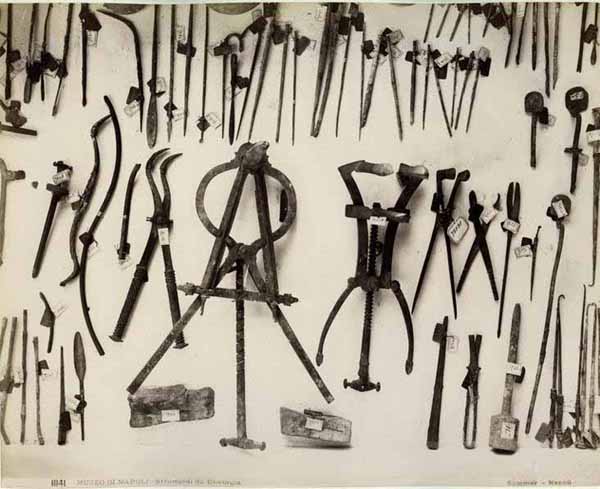
Scalpels, made of steel or bronze were used to make incisions. Scalpels could be made of either steel, bronze, or a combination of the two metals - such as a steel blade and a bronze handle. A military hospital at Baden has produced a large collection of medical tools.
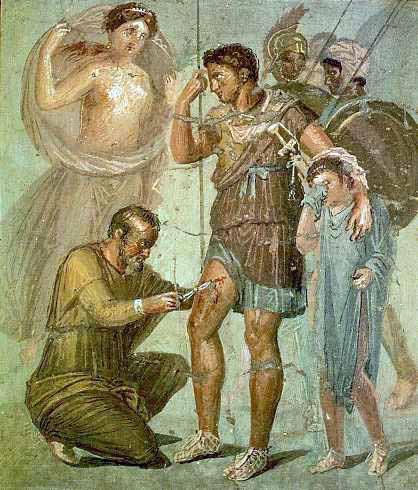
A stone mural of Roman legion depicts a fellow solider helping another remove probably an arrow from his leg with a pair of pinchers. Some soldiers were skilled in medical while still serving in the army. The negative realm of Roman medicine started in its early history.
Scapels
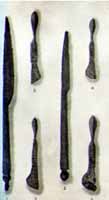
Ancient scalpels had almost the same form and function as their modern counterparts do today. The two long steel scalpels that make up the first and third columns of the accompanying image are examples of the most ordinary type of scalpel from antiquity. These long scalpels could be used to
make a variety of incisions, but they seem to be particularly suited to making either deep or long cuts.
The four bronze scalpels which make up columns two and four are generally referred to as "bellied scalpels." This variety of scalpel was another favorite of physicians in antiquity since the shape of its handle allowed more delicate and precise cuts to be made.
Bone Hooks
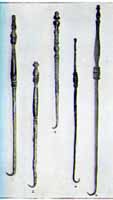
Hooks, long thin metal instruments were used as probes and the maneuvering small pieces of tissue more easily. Hooks were another common instrument used regularly by Greek and Roman doctors. The hooks the ancient doctors used came in two basic varieties: sharp and blunt. Both of these types of hooks are still used by modern surgeons' for many of the same purposes for which the ancient doctors first used them. For instance, blunt hooks were primarily used as probes for dissection and for raising blood vessels. Sharp hooks, like those pictured in the accompanying image, were used to hold and lift small pieces of tissue so that they could be extracted and to retract the edges of wounds.
Bone Drills
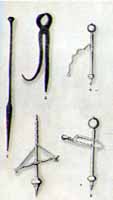
Bone drills, looking like wine cork screws were used to remove diseased bone tissue from the skull and extract sizable foreign objects such as a weapon from a bone. Bone forceps were used to extract small pieces of bone that would be otherwise difficult to remove with fingers.
Bone Forceps
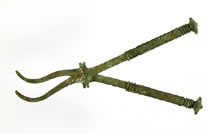
In the case of impaction of the foetal cranium, the head may be opened with a sharp instrument and the pieces of the skull removed with bone forceps. Paul Aigenita (VI.xc) wrote that in a depressed fracture of the skull fractured bone is to be removed in fragments, with the fingers if possible, if not, with a bone forceps.
Bone Levers
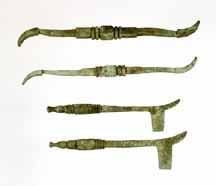
Used for levering fractured bones into position and may have been used for levering out teeth.
Vaginal Speculum
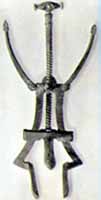
One of the most spectacular, if fearsome looking, Roman medical instruments is the vaginal dilator or speculum (dioptra). It comprises a priapiscus with 2 (or sometimes 3 or 4) dovetailing valves which are opened and closed by a handle with a screw mechanism, an arrangement that was still to be found in the specula of 18th-century Europe. Soranus is the first author who makes mention of the speculum specially made for the vagina. Graeco-Roman writers on gynecology and obstetrics frequently recommend its use in the diagnosis and treatment of vaginal and uterine disorders, yet it is one of the rarest surviving medical instruments. Specula are large and readily recognizable and should not have suffered the same degree of destruction as thin instruments, such as probes, scalpels and needles. As a source of bronze, however, they may have been more subject to recycling than the smaller instruments.
Rectal Speculum
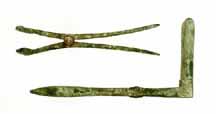
The earliest mention of the rectal speculum is to be found in the treatise on fistula by Hippocrates (iii.331): "Élaying the patient on his back and examining the ulcerated part of the bowel by means of the rectal speculum..."
Male Catheter

Catheters, long metal tubes, like those we have today were used to help open up a blocked urinary tract infections.
Probes or Curettes
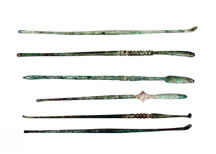
The scope of the cyathiscomele in medical art is evidently, like the flat spathomele, to act occasionally as a sound, but mainly to mix, measure and apply medicaments. Some are adapted for use as curettes. The large numbers in which this instrument occurs would itself indicate that it was used for lay as well as medical purposes.
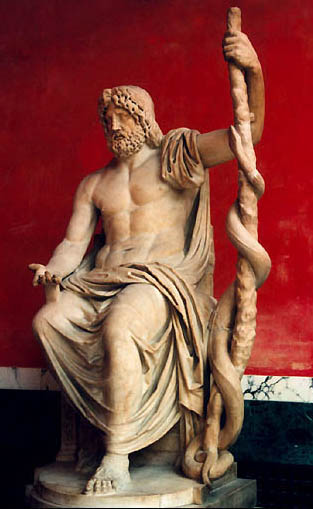
Greek God of Medicine and Healing
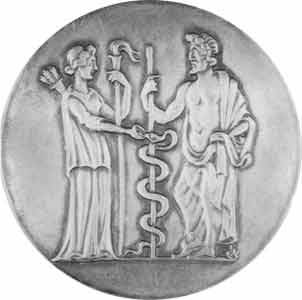
Asclepius (center) and Hermes (bending) - also show as Mercury (far left)
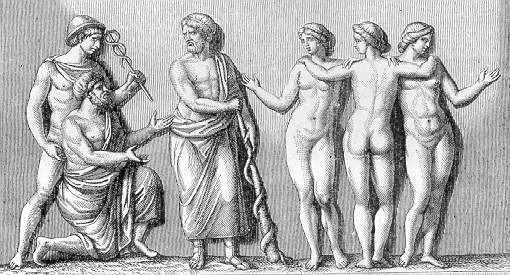
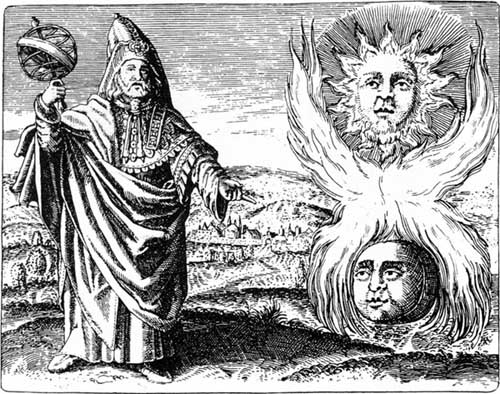
Hermes was the Greek version of the Roman God Mercury. This goes to Hermes Trismegistus, Alchemy, The Emerald Tablets of Thoth, and the Thoth-Hermes of the Greco-Roman-Egyptian period in the days of the great Library at Alexandria.
When the Roman Army conquered Greece they adopted many of their medicinal beliefs and ideas.
Asclepius is the god of medicine and healing in ancient Greek religion. Asclepius represents the healing aspect of the medical arts; his daughters are Hygieia ("Hygiene", the goddess/personification of health, cleanliness, and sanitation), Iaso (the goddess of recuperation from illness), Aceso (the goddess of the healing process).
The cult of Asclepios had spread across much of Greece and numerous temples (asclepieions) had been built in his name. These Asclepieions (or Asklepieions) were places of healing. They contained baths, gardens and other facilities designed to improve people's health. People who were being treated in the Asclepieions would sleep in front of a statue of the Greek God in the hope that he would heal them in their sleep. Though several accounts have been recovered, detailing the progress in health made by people admitted to the Asclepieions, it is unlikely that they were based on fact; they may simply have been used as propaganda.
Tiber Island in Rome was once the location of an ancient temple to Aesculapius, the Greek god of medicine and healing. Accounts say that in 293 BC, there was a great plague in Rome. Upon consulting the Sibyl, the Roman Senate decided to build a temple to Aesculapius, the Greek god of healing, and sent a delegation to Epidauros to obtain a statue of the deity. They obtained a snake from a temple and put in on board their ship. It immediately curled itself around the ship's mast and this was deemed as a good sign by them. Upon their return up the Tiber river, the snake slithered off the ship and swam onto the island. They believed that this was a sign from Aesculapius, a sign which meant that he wanted his temple to be built on that island.